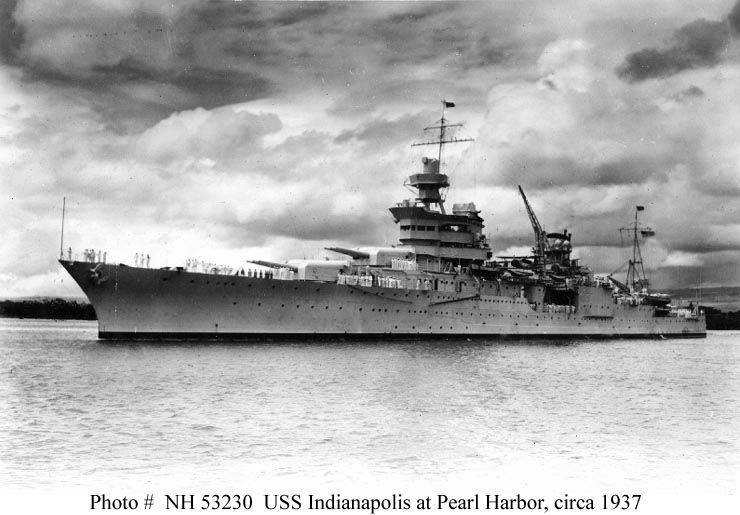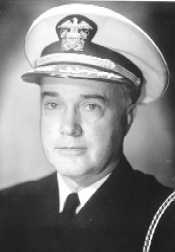The Tragedy of the USS Indianapolis

Still at Sea
The Tragedy of the USS Indianapolis
Still at Sea |
 |
Captain
Charles
Butler McVay,
III
Born July 30, 1898 His Grief Ended November 6, 1968 |
|
|
|
| Written
by Tenna
Perry In the classic horror movie “Jaws” there is a character played by actor Robert Shaw who tells the story of a World War II cruiser, which sank after completing a top secret, run to Tinian Island in 1945. This ship's name was the USS Indianapolis. (Click here to read narration) The cruiser known as the USS Indianapolis (CA-35) was laid down on March 31, 1930 by the New York Shipbuilding Corp. and launched on November 7, 1931 with Captain John M. Smeallie in command. Several times during the peace before the Japanese attack upon Pearl Harbor the Indianapolis would carry President Franklin Roosevelt and members of the cabinet for meetings and the President's “Good Neighbor” cruises to South America. On November 1, 1933 she became the flagship of the United States Scouting Force and remained as such for the remainder of peacetime before Pearl Harbor. When the Japanese bombs dropped on Pearl Harbor, the Indianapolis was making simulated bombardments of Johnston Island. She immediately stopped her maneuvers at Johnston and headed for Pearl Harbor to join Task Force 11 on December 13, 1941. Their mission was to search for Japanese carriers that were supposed to still be in the area. During the war, the Indianapolis would go into action in some of the heaviest of South Pacific battles. Rabaul and Salamaua as well as Kiska Island and Attu in the Aleutians were just the beginning of her wartime battles. In November of 1943 she was a part of the assault force for Operation “Galvanic” in the Gilbert Islands as well as participating in the battles in January 1944 for the Marshall Islands. Tarawa, Makin and Kwajalein Atoll were just a few of the famous engagements in which the Indianapolis participated. In June 1944 the ship played a major role in the Marianas assault, the raids on Saipan and the Battle of the Philippine Sea as well as Iwo Jima and Chichi Jima. On March 4, 1945 a pre-invasion bombardment of Okinawa began and the Indianapolis participated in this and then on March 31st, the day before the actual invasion, the lookouts spotted a single engine Japanese fighter plane as it vertically dove at the bridge. The ship's guns began firing but less than 15 seconds after it was first seen, the plane was over the ship. Although the plane was hit by tracer shells and caused to swerve, the pilot was able to release his load at a mere 25 feet above the ship. As the plane crashed into the port side of the of the after deck, the bomb itself pierced through the deck armor and continued through the crew’s mess hall, the berthing compartment, the fuel tanks and the bottom of the ship. It finally exploded in the water beneath and the concussion blew two holes in the ship's bottom, killed nine crewmen as well as flooded compartments in the area. Settling slightly to the stern and listing to port, the cruiser was able to steam to a salvage ship for emergency repairs under her own power. During the repairs, it was discovered her propeller shafts were damaged, fuel tanks ruptured and her water-distilling equipment completely ruined. Surprisingly, even with the damage the Indianapolis was able to complete the long trip across the Pacific to Mare Island for extensive repairs and an overhaul still under her own power. Once the repairs were completed, the fate of the Indianapolis and her crew were to be forever changed. She received orders to forego the post repair shakedown cruise and proceed at top speed to San Francisco to pick up cargo and then to deliver it to Tinian. Capt. Lewis L. Haynes who was the senior medical officer on board the Indianapolis wrote later of how they arrived at an almost deserted Navy Yard and two large trucks came alongside the ship. One of the trucks had a huge crate that was immediately put into the port hanger and the other truck had several men as well as Army officers Capt. James Nolan and Maj. Robert Furman. These two men carried a three-foot by four-foot tall canister up to Admiral Spruance’s personal cabin and welded it to the deck. The Captain of the Indianapolis at this time was Capt. McVay and all he told his senior officers of the mission was that it was special. He even admitted, “I can’t tell you what the mission is. I don’t know myself but I’ve been told that every day we take off the trip is a day off the war.” Capt. McVay also informed his officers that if for any reason the orders were given to abandon ship, the canister in the Admiral’s cabin was to be place in a boat before any crewmember. From an empty Naval Yard in San Francisco to an equally quiet Pearl Harbor for refueling, the Indianapolis proceeded at top speed and unescorted to Tinian and in doing so, set a record by covering the 5000 miles from San Francisco in only ten days. Once at Tinian the cargo was unloaded, she proceeded to Guam to disembark several men and was given orders to report to Vice Adm. Jesse Oldendorf for duty in the vicinity of Okinawa. Capt. McVay was told to take a direct route and although he requested one, an escort was denied. He was informed the route would be safe but later would find that Naval Intelligence actually knew there were Japanese submarines in the area. Two days out of Guam at 12:15 a.m. on July 30, 1945 in moderate seas and good visibility, torpedoes from Japanese Sub I-58 with Commander Machitsura Hashimoto in command, hit the USS Indianapolis. The explosions were against her starboard side and the mighty ship capsized, sank in only 12 minutes and sent 1199 crewmembers into the sea. Her location at this time as 12 degrees 02 minutes N., 134 degrees 48 minutes E. Capt. McVay would later be charged for negligence of duty and a variety of other things but the true negligence was on the part of the Navy. The Indianapolis was due to reach Leyte on July 31, 1945 but no report was ever made when she didn’t arrive on schedule. In fact, on August 2, 1945 when a plane on routine patrol accidentally came across the survivors at 10:25 a.m. a report still had not been filed. The pilot of the plane immediately radioed for help, dropped a life raft and a radio transmitter to the survivors but it would be August 8th before rescue operations in a hundred mile radius had been combed with survivors was found throughout. The rescuers usually found the men in groups but a great number of the crew had gone into the water wounded or without life jackets. Officers tried to herd the men together and have the ones without jackets to put their arms through the shoulders of someone else’s jacket while desperately attempting to keep the men from drinking the seawater. Capt. Hayes reported no attacks from sharks in his group but reports from other groups told horrific stories of them and in the end, of the 1,199 crewmen who went into the water, only 316 were found alive. Capt. Charles McVay would be vindicated from any blame concerning the loss of the Indianapolis but its sinking would haunt him the rest of his career until he committed suicide years later. One of the main witnesses at his trial was Commander Machitsura Hashimoto who told the board that no special maneuvering by Capt. McVay would have changed the outcome of the submarine attack. The personnel who failed to report the ship not arriving on schedule at Leyte would also be exonerated. The USS Indianapolis traditionally served as the flagship of the 5th Fleet and during her 14 years of service, she was honored with 10 battle stars for her actions during World War II. |
Nation Visitors Since March 8, 2013